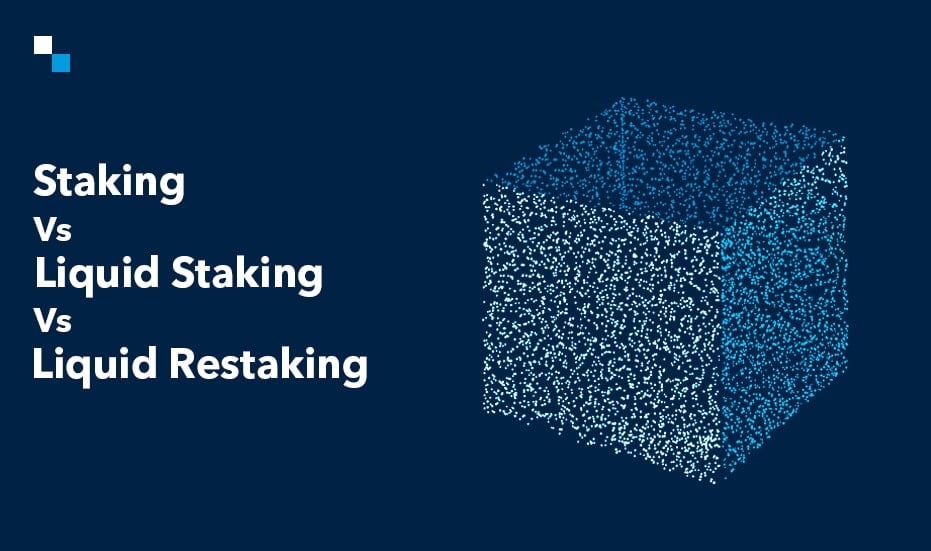In the world of DeFi staking, liquid staking, and liquid restaking are key mechanisms that offer various ways to earn rewards and enhance investment returns. Each approach has its own set of benefits and operational details. This blog will provide a thorough overview of these concepts, making it easier for you to understand and choose the best option for your needs.
Understanding Staking
Staking is a process used in blockchain networks, especially those that use Proof-of-Stake (PoS) or similar consensus mechanisms. It involves committing a certain amount of cryptocurrency to support the network’s operations.

How Staking Works:
- Choosing a Staking Network: To begin staking, you first need to choose a blockchain network that supports staking. Examples include Ethereum (after its transition to PoS), Cardano, and Polkadot.
- Locking Your Assets: Once you’ve selected a network, you deposit your cryptocurrency into a staking contract or wallet. This process involves locking your assets for a specific period, which means you cannot trade or withdraw them during this time.
- Participating in Network Operations: Your staked assets are used by the network to perform essential functions such as validating transactions and creating new blocks. This process helps secure the network and ensures its smooth operation.
- Earning Rewards: In return for locking up your assets and helping maintain the network, you earn rewards. These rewards are typically distributed periodically and are paid in the form of additional cryptocurrency.
Pros and Cons of Staking:
Pros:
- Provides a stable and predictable income stream through rewards.
- Contributes to the security and functionality of the blockchain network.
Cons:
- Assets are locked up for a specific period, limiting your ability to access or trade them.
- Potential for reduced liquidity, meaning you may not be able to quickly convert your assets into cash.
Exploring Liquid Staking
Liquid Staking is an advanced form of staking designed to address the liquidity constraints of traditional staking. It allows users to stake their assets while still retaining access to a derivative token that represents their staked assets.
How Liquid Staking Works?
- Deposit into a Liquid Staking Protocol: You start by depositing your cryptocurrency into a liquid staking protocol. This protocol is typically provided by specialized services or platforms.
- Receive Liquid Staking Tokens: In exchange for your staked assets, you receive liquid staking tokens (or staking derivatives). These tokens are a representation of your staked assets and are often designed to be traded or utilized in other DeFi applications.
- Utilize Liquid Tokens: With your liquid staking tokens, you can participate in various DeFi activities, such as lending, borrowing, or trading. This allows you to keep your assets productive and potentially earn additional rewards.
- Earning Dual Rewards: While your assets are staked and earning rewards, you also benefit from the liquidity provided by the liquid staking tokens. This can enhance your overall return on investment.
Pros and Cons of Liquid Staking:
Pros:
- Maintains liquidity through the use of derivative tokens while earning staking rewards.
- Allows participation in additional DeFi activities without losing staking benefits.
Cons:
- The value of liquid staking tokens can fluctuate, potentially affecting your overall returns.
- There may be fees associated with using liquid staking services.
What is Liquid Restaking?
Liquid Restaking builds upon the concept of liquid staking by allowing you to restake your liquid staking tokens. This approach adds another layer of staking to further amplify rewards and optimize returns.
How Liquid Restaking Works?
- Initial Liquid Staking: Begin by staking your cryptocurrency through a liquid staking service and receive liquid staking tokens.
- Deposit into a Restaking Protocol: Take your liquid staking tokens and deposit them into a second staking protocol that supports restaking. This additional layer of staking allows you to earn further rewards on top of those generated by your initial staking.
- Compounded Rewards: By restaking your liquid staking tokens, you benefit from compounded rewards. The rewards from the initial staking are reinvested, leading to enhanced earning potential across multiple staking layers.
Pros and Cons of Liquid Restaking:
Pros:
- Maximizes rewards by leveraging multiple layers of staking.
- Enhances return on investment through compounding effects.
Cons:
- Increased complexity and management required to optimize returns.
- Additional risk associated with multiple layers of staking and fluctuating token values.

Comparative Summary
- Traditional Staking: Best for those looking for a steady income stream and willing to lock up their assets for a period. Ideal for securing the blockchain network.
- Liquid Staking: Suitable for users who want to earn rewards while retaining liquidity through derivative tokens. Offers flexibility and additional DeFi opportunities.
- Liquid Restaking: Best for advanced users aiming to maximize returns through compounded rewards. Adds complexity but offers significant potential for increased earnings.
Conclusion
Understanding staking, liquid staking, and liquid restaking is crucial for navigating the DeFi landscape effectively. Each method offers unique advantages and caters to different investment strategies. Whether you are looking to secure a network, maintain liquidity, or maximize returns through compounding, knowing how these mechanisms work will help you make informed decisions and optimize your investment approach.
For those interested in developing custom staking solutions or exploring advanced DeFi strategies, staying up to date with these innovations can significantly impact your success and overall investment strategy. Want to build a staking or restaking platform? Get in touch with Antier, the best DeFi development company for all your needs.





